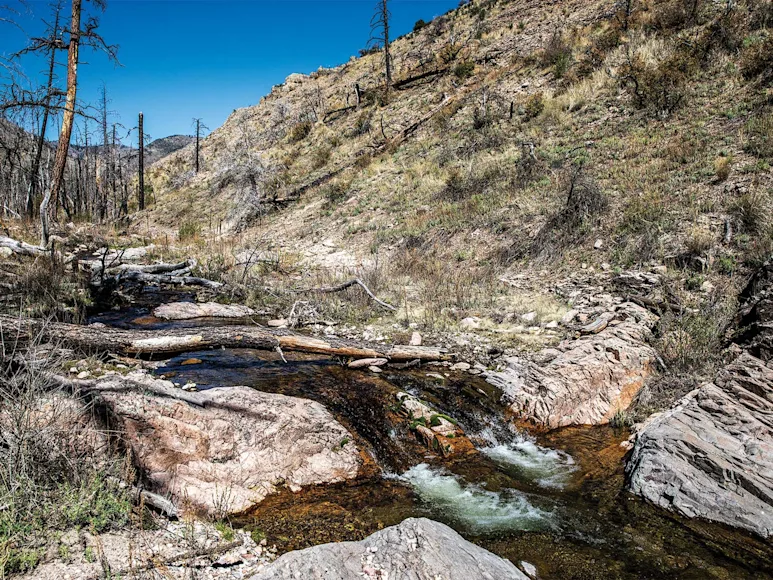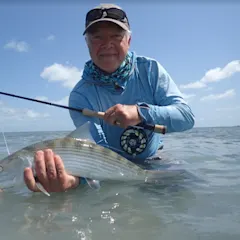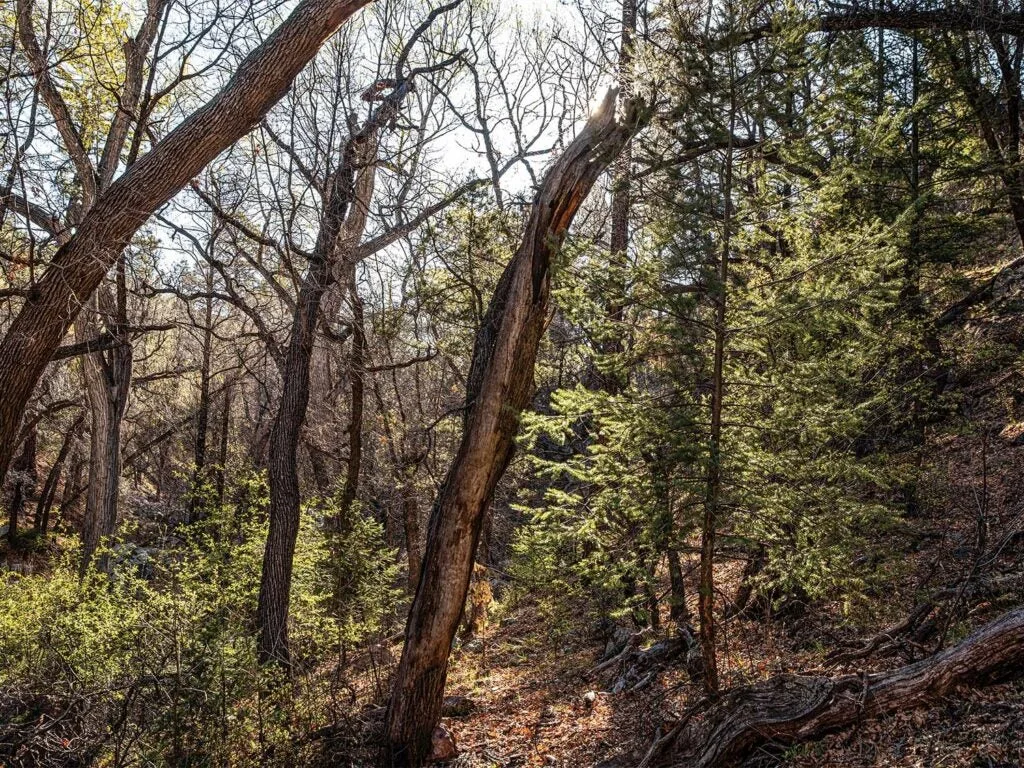
The Aldo Leupold Wilderness is a great place to lose yourself. Tom Fowlks
The tom arrowed down through the piñon pines of the Aldo Leopold Wilderness. We were hunting public land—a national forest in New Mexico—and the bird’s challenging cries rang from the canyon walls. I could hear every gobble and step yet couldn’t get a visual on the bird. But Ted Koch could. He was 15 feet to my left, in a spare brush blind, hands on a traditional bow, and when I saw him drop his eyes to the ground, I knew the tom was closing in—and very close to dead.
Then, in an instant, everything that was right turned not-quite-right. The gobbler stepped into view and froze, head erect and eyes alarmed. I tried to stymie every possible movement—my eyes, my chest rising with each breath—and then the air came out of the turkey like a punched tire. Where once stood a full-blown strutting gobbler now appeared a slender reed of a bird, and a bird making himself smaller by the second. As he turned to run, I brought up the gun, but it was too late. The chance was lost.
I had schemed on this trip for a year with my buddy Koch, who recently retired from running the U.S. Fish and Wildlife Service’s endangered species program in the Southwest. We planned to take mules and horses deep into the Gila National Forest to hunt Merriam’s turkeys. The Gila is America’s first wilderness area, proposed for designation in 1924 by Aldo Leopold, author of A Sand County Almanac and long considered the father of modern wildlife management. The area shares a boundary with the 202,000-acre Aldo Leopold Wilderness, designated in 1980 in Leopold’s honor. Together, the landscape of soaring rimrock and deep canyons runs for 27 miles north to south and 39 miles east to west, roadless but for a single gravel Forest Service road. There are few better places in which to lose yourself in raw, wild country, and navigate the days based on whatever such country throws your way.
On a mid-April morning, with skies spitting snow and sleet, our packer, Mike Root, helped Koch, photographer Tom Fowlks, and me into the Aldo Leopold Wilderness. Mule hooves clattered on stony trails that wound through cottonwood canyons and along cactus-clad ridges. We pitched two tepees beside a creek and bid Root and his pack string goodbye for five days. We had gear, food, and maps—and not a clue where turkeys could be found in the big nowhere that unfurled around us. We couldn’t have been more excited.
A Break in the Action
When that first gobbler bolted from near-certain death, he kicked off a day and a half of patience-shredding, run-and-gun turkey hunting for henned-up toms. I watched one hen wade a shallow creek for 45 minutes while Koch called to her mate, hidden in the cliffs above. The gobbler answered everything Koch threw at him, but neither he nor the hen wavered. They only had eyes for each other. Half a day later, with another bird gobbling on demand, I pushed my luck. With a shotgun in one hand, a turkey fan in the other, and a push-button yelper clenched between my teeth, I belly-crawled for an hour as Koch hung below a ridgeline and rattled the bird with yelps, cutts, and gobbles. A dozen feet away, a coyote stalked the same bird, so transfixed by the near-constant gobbling that it never saw me huddled on the ground. I pulled up 75 yards away from the henned-up tom and let him have it with two calls. He gave it right back—without budging an inch. I finally gave up and crawled back down the ridge. Koch and I conferred on the creek, shoulders slumped.
“Knowing that they’re henned up,” he said, “I feel a little better about being ignored.”
“Maybe,” I replied. “But it sure hurts my feelings to strike out.”
It seemed like we needed a change of scenery, so the three of us struck off on a long-distance scouting venture. A mile and a half up the creek lay a long, wide canyon. On the map it appeared to be a turkey nirvana—a flat valley floor cut with side canyons, meadowed and timbered. Getting there required dozens of creek crossings, and at one point the canyon narrowed to a 10-foot-wide pass between soaring cliff walls. We clung to the rocks, edging over the water, plunging through dog-hair stands of willow and alder.
But the canyon was a bust. Recently burned, it was a chasm of fire-blackened logs, dead snags, and sandy, bleached soils where a turkey could see us working through the barrens from a half-mile away. Koch and I sent a few yelps up the side canyons in case one might hold the odd bird, but the canyon felt empty and lifeless.
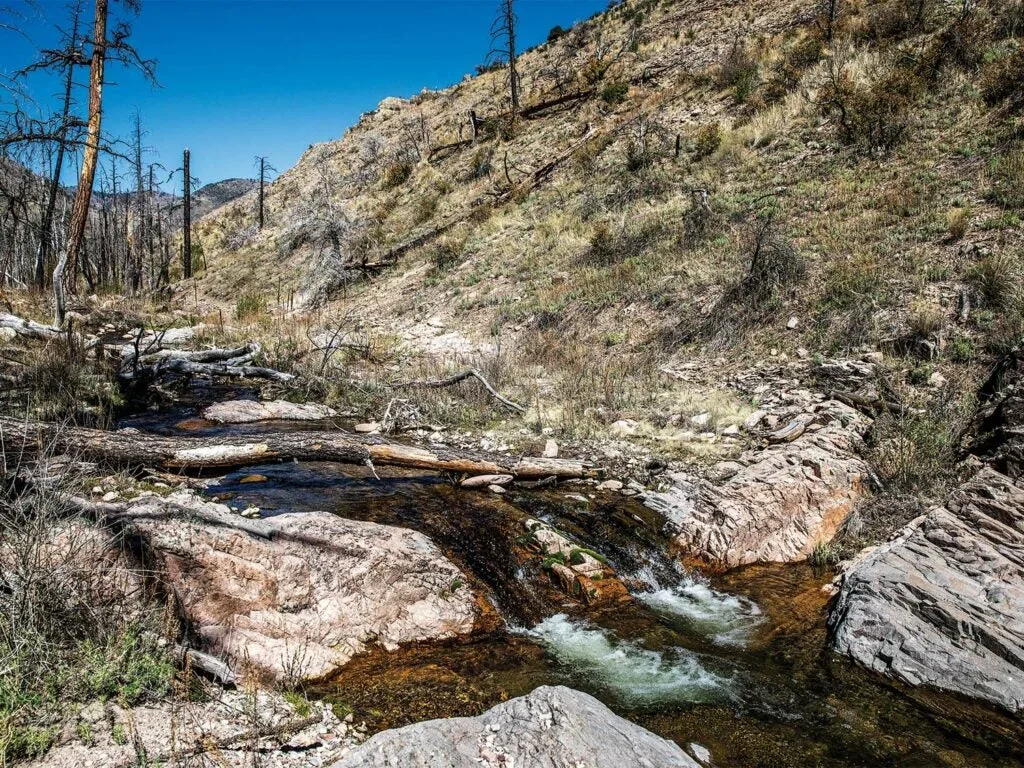
Even minor obstacles, like a mountain stream, can create problems in the backcountry. Tom Fowlks
We turned around to hoof it back in retreat. Dead ends and scuttled plans are a part of hunting backcountry—especially unknown country—but working our way out of the canyon and back downstream, the waste of precious hours and energy gnawed in my gut. With every stream crossing, I seemed to fret more about the tough birds and the waning days. Willows crowded the streambank. We all lost sight of each other in the streamside thickets as we strung out along the narrow canyon floor. Suddenly, I heard a violent splash, and a deep groan from upstream.
I whipped around and bashed through the willows. Fowlks was lying in the creek, cradling his right arm in his lap. He groaned again, his eyes glassy and fixed on his wrist.
I hollered for Koch and helped Fowlks to his feet. He winced in pain. The injury wasn’t life-threatening, but I could tell from the contorted wrist, twisted like an owl’s head and sheared at a sickening angle, that we needed to deal with this quickly. Koch and I whittled willow splints for Fowlks’ arm, wrapped them in duct tape, and assessed our options. Looking back, it’s still surreal how fast everything changed. We started walking. The hunt was over.
Rekindling the Green Fire
When Aldo Leopold first traveled to this rough country in 1909, he was 22 years old and fresh out of the Yale School of Forestry. A farm boy from Iowa, Leopold was a birder and hunter, but he must have been wild-eyed at the raw Southwest. New Mexico and Arizona were still U.S. territories, and one of his early assignments was to kill bears, mountain lions, and wolves in Arizona’s Apache National Forest to placate the ranchers, who loathed the animals. It was the killing of a wolf there that kicked off a tectonic shift in Leopold’s perspective on ecology, and led him to frame a concept of wildlife management that deeply informs both science and land ethics today.
He and a survey team were eating lunch on a high cliff in the Apache when they spied a mother wolf and her pups. “In those days, we had never heard of passing up a chance to kill a wolf,” he wrote, decades later, in A Sand County Almanac. So they didn’t. The young men opened fire, then hiked down to the foot of the rimrock. Leopold reached the mother wolf, an “old wolf,” he wrote, “in time to watch a fierce green fire dying in her eyes. I realized then, and have known ever since, that there was something new to me in those eyes—something known only to her and to the mountain.”
Around our campfire, on our first night in the Aldo Leopold Wilderness, a Dutch oven hissed in the coals while a single Merriam’s gobbled for an hour on the ridge above the tepees. Koch, Fowlks, and I wrangled with the challenges presented by Leopold in his essay on that wolf killing, which he titled “Thinking Like a Mountain.” We’d come to this country to hunt turkeys, but we also wanted to steep ourselves in Leopold’s writings and pay homage to his pioneering expression of our moral responsibility to the natural world, be it the backcountry or a city creek. Our plates were heaped with a stew of wild duck, country ham, and vegetables blackened in an iron pot, and we ate as the gobbling and the campfire died away. The place and role of wolves in the wild is a complicated, multifaceted issue, but Leopold’s writing has deeper resonance than predator control. A Sand County Almanac is a call to a type of ethical arms every bit as relevant today as in Leopold’s world. “Thinking Like a Mountain” is about the killing of a wolf, certainly, but it is also about the severing of humanity’s ties to a world where wolves can remain, and the ragged strands such a rending leaves behind. His work hints at the conflicts of living in an overly tamed age, and it explores the losses of living in a world where fewer people value the mountain’s point of view. Or even seek it. Leopold recognized the too-much of the civilized life—just as I recognize the starved bones of my own soul when I stray too far from a connection to the wild world.
“We all strive for safety, prosperity, comfort, long life, and dullness,” he wrote in A Sand County Almanac. For many of us, wild country is the only antidote for that dullness. But out there, as I learned when Fowlks slipped in the stream, we don’t always get to choose how that dullness is abated.
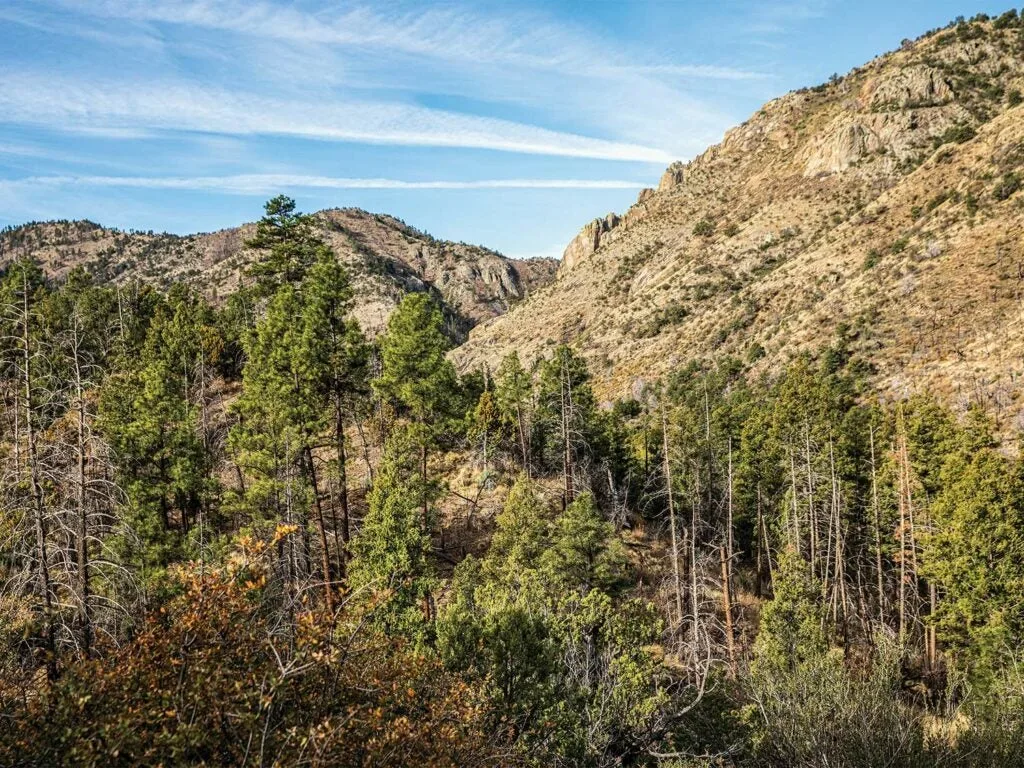
The 202,000-acre Aldo Leopold Wilderness is sacred ground for backcountry advocates. Tom Fowlks
Getting Lost
It took nearly 30 hours of careful hiking and climbing, plus a midnight dash to Albuquerque to get Fowlks to a hospital. My chance at a wild Merriam’s was lost, and I don’t know if I’ll ever return to Leopold’s wilderness to hunt one again. I’d like to think I will—to close all the circles left open by our sudden evacuation—but as we were walking Fowlks out of the woods, my mind kept going back to a moment when I felt most connected to this place, and what we were trying to do here beyond the killing of a turkey.
Three days earlier, scouting on the afternoon before the Monday morning opener, I hiked out of our campsite meadow to climb a steep ridge that led to a knife-edged hogback. I sat against a piñon pine and glassed the steep canyon below. I could smell the conifers, hear the wind, and see to infinity. I pulled out a notepad and began to write.
Everything before me was pure wilderness. I watched a bull and cow elk sift out of the timber and move through a meadow harrowed by a flock of turkeys. The landscape felt permanent, unyielding, and wholly disconnected from the world beyond the horizon, but I knew what these mountains could not know: The future of such wild places lies far beyond the horizon, in a world where lines on a map and words on paper—laws and policy and the human lust for treasure—defines its fragile reality.
Thirty-five years after he killed that mother wolf and her pups, Leopold wrote: “I now suspect that just as a deer herd lives in mortal fear of its wolves, so does a mountain live in mortal fear of its deer.” The natural world is a cosmic, living Jenga tower, and Leopold understood the ineluctable forces that push against balance. No piece or part is without value. To think like a mountain means to live as a citizen of the landscape, he wrote. Not its conqueror.
On my own seat in the rimrock, not so far from Leopold’s historic perch above the wolves, I understood more deeply the fear that has taken deep root in my own spirit: That all wildness will be pruned away from this world—ingested by concrete, scored by roads, pocked with drilling rigs and cell towers—and human experience defoliated of the lushness of the empty and roadless places. We spend too much time striving for dullness, and not enough in places so remote and removed that both renewal and peril are a possibility with every step across a stream.
Leopold wrote of the deep relationship between mountain, wolf, and deer, and of the similar symbiosis reflected in the human experience with blank places on a map. Every hunter feels this. I felt it as I hiked back down the ridge that evening, moving into the dark night as if wading into baptismal waters. And I recognized it on our first night in camp, when that lone tom on the ridge behind the tent gobbled like crazy, in a place so wild that I wondered if any other human had ever heard his challenging cries.
There was something in those eyes known only to the wolf and the mountain. Perhaps that something is, ultimately, unknowable to the modern hunter, no matter how passionately we pursue it. But to those of us who still feel the heat of the wolf’s fierce green fire, this we know: It is these last untrodden places that fill our souls with understanding and purpose. The lessons they teach us, just like the journeys we take there, are often surprising and sometimes unwelcome. But with each diminished connection to the world of wolves and elk and wild turkeys gobbling in the starlight, we lose a tenuous handhold on our journey toward who we might be at our very best.

